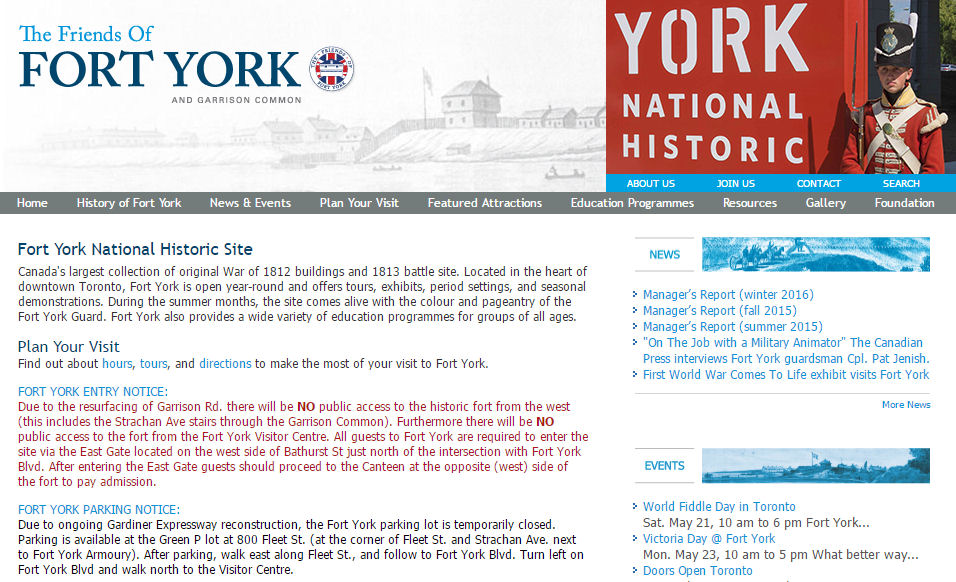Speaking from the garrison
Meet David O’Hara, Fort York’s new administrator
By Tom G. Kernaghan
David O’Hara is clear about what is important to him in his role as Fort York’s new administrator. The former City of Toronto planner hopes to bring the museum and the city closer together.
“The whole context is changing down here,” says the 36-year-old O’Hara, who has a degree in landscape architecture from the University of Guelph and a master’s of science in urban planning from the University of Toronto. “We are strengthening connections to existing neighbourhoods.”
In his new role at the location he calls “one of the city’s most important historical sites,” he aims not only to preserve the city-owned Fort York and its lands, but also to enhance the site, heighten its physical presence, further improve vehicular and pedestrian access from Fort York Boulevard, and increase attendance. In short, he wants to cultivate greater public awareness of the land he knows very well.
During his 12 years as a city planner, O’Hara, a Toronto native, helped create the Public Space Framework plan for the Central Waterfront and served as project leader for the Harbourfront Parks & Open Space System, including Maple Leaf Quay and HTO Park.
He also worked with Jo Ann Pynn, his predecessor at the museum, to help ensure Fort York was an important part of the city’s linked cultural corridors and a central feature in the revitalization of the waterfront.
“Whenever I looked at the waterfront, I saw that Fort York was a big part,” he says. “Fort York is becoming the nucleus for the development of the area.” He adds the site is “the birthplace of modern day Toronto.”
Lieutenant Governor John Graves Simcoe built the original garrison in 1793, a move that allowed for the creation and growth of the city. Over the years, the fort has been attacked by Americans (in 1813), threatened by the Gardiner Expressway, and overlooked by commuters. Fort York became a museum in 1934, and since then students and tourists have visited the grounds to learn about key periods in our military history.
O’Hara wants to expand that interpretation.
“The military history is a priority,” he says, “but there are many other stories to be told, and we want to tell all of the stories that took place on the site. You can’t tell the story of Toronto’s development without talking about Fort York. And it’s the story of [American] and Canadian relations.”
“I don’t have a history degree,” admits O’Hara, “but I have always had an interest in history and cultural heritage landscapes.”
While at university, he studied heritage conservation and cultural heritage landscapes. And he acknowledges that his learning curve involves distinguishing between parkland development and historical site projects.
“You have to take extra care when restoring or designing [historical sites],” says O’Hara. “Doing things at the fort makes everything more complicated. You have exhibits that are fragile and valuable…. And research is necessary when doing building restorations, to learn how they were done originally.”
However, all of his projects are similar in that he approaches them with a consistent work ethic.
“When I take on a project, I learn and take stock of what is involved, whether archeological, historical, or physical.”
One physical change he would like to see is the construction of a modern main office for the staff, in order to free up the current one, which dates back to 1815, for exhibition purposes.
O’Hara understands that growth requires money. Currently the museum is funded by the city, the Friends of Fort York’s fundraising efforts, donations, provincial grants, The Richard Ivey Foundation, and visitor admission fees—the “self-generating” income O’Hara wants to generate more of.
He also knows that money requires awareness.
“I hope we can form a critical mass of attraction,” says O’Hara, in reference to Fort York’s proximity to Ontario and Exhibition places, though he is not aware of any plans to join administrative forces with those organizations.
Looking forward, he is happy to be among dedicated company closer to the fort.
“The volunteers here are amazing. The Friends, the people involved, keep coming back, still passionate about the place.”
For more information on Historic Fort York visit http://www.fortyork.ca/ or http://www.city.toronto.on.ca/culture/fort_york.htm. And for more information on the waterfront revitalization plans, visit http://www.towaterfront.ca.
(Gleaner News, Toronto)

